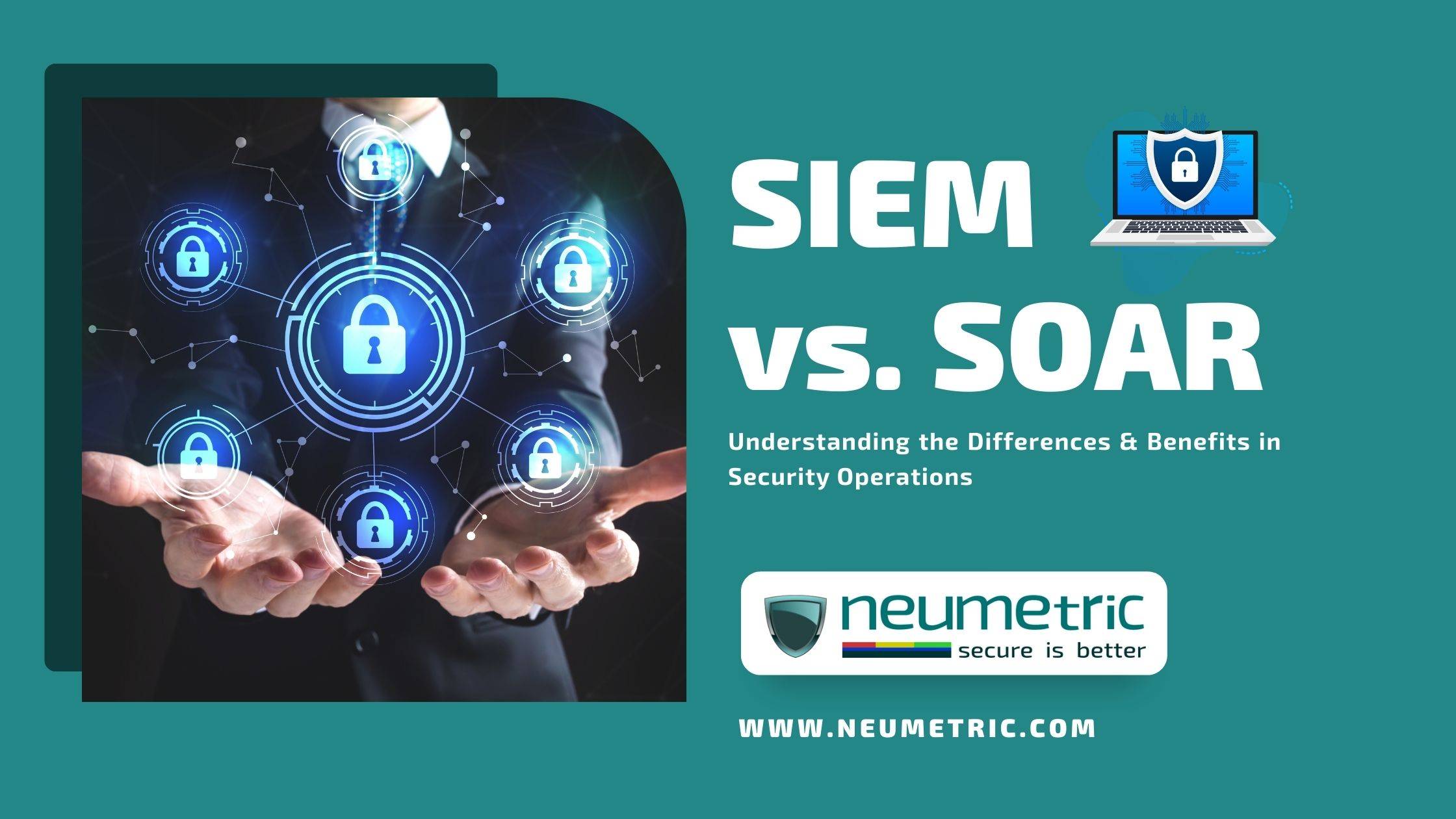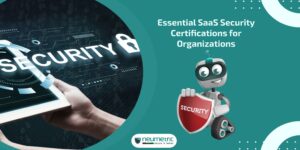Table of Contents
ToggleSIEM vs. SOAR: Understanding the Differences & Benefits in Security Operations
Introduction
To keep up with the digital threat landscape, organisations need robust security technologies & processes. Two technologies that have become essential for modern Security Operations Centres [SOCs] are Security Information & Event Management [SIEM] & Security Orchestration, Automation & Response [SOAR]. While related in purpose, SIEM & SOAR serve distinct roles. Understanding the key distinctions between these technologies is crucial for implementing the appropriate solutions & maximising their effectiveness.
SIEM & SOAR both aim to strengthen security monitoring, incident response & threat mitigation capabilities. However, SIEM focuses on gathering security data from multiple sources & enabling threat detection & analysis. SOAR concentrates on streamlining & automating workflows to accelerate & improve incident response. Organisations need to evaluate their own requirements, resources & use cases to determine if SIEM, SOAR or a combination of both will provide the right capabilities for their security needs.
This Journal will examine SIEM & SOAR in depth – their definitions, purposes, features, benefits, limitations & differences. We will also explore considerations for selecting the appropriate technology & provider to meet an organisation’s unique security operations needs & challenges. Equipped with an understanding of SIEM & SOAR, security teams can make informed decisions on implementing solutions tailored for effective, efficient & scalable security operations.
Understanding SIEM
Security Information & Event Management [SIEM] refers to a technology that aggregates & analyses security data such as events, alerts, logs & threat intelligence from across an organisation’s technology infrastructure & applications. The core purpose of a SIEM is to monitor activity across networks, endpoints, cloud environments & other systems to detect security incidents & compliance violations.
Key goals & use cases of SIEM technology include:
- Centralised collection & correlation of security event logs & data from multiple sources.
- Real-time monitoring & analysis of security events to detect threats.
- Matching logs & events against known indicators of compromise & threat intelligence.
- Generating notifications & alerts when a possible security incident occurs.
- Producing dashboard views & formatted reports for threat monitoring, analysis & compliance auditing.
- Retaining event log data for a defined time period to facilitate forensic analysis & investigations.
SIEM platforms offer a robust set of capabilities that empower security teams to get greater visibility across their environment, accelerate threat detection & simplify compliance processes. Key features include:
- Log management: Collect & store log data from security devices, servers, endpoints, networks, cloud services, applications & other sources.
- Real-time monitoring: Monitor & analyse security event data in real-time to detect anomalies or threat indicators.
- Incident management: Manage the incident response process with workflows for alert creation, assignment, investigation & documentation.
- Compliance reporting: Produce reports proving compliance with regulations & standards like Payment Card Industry Data Security Standard [PCI DSS], Health Insurance Portability & Accountability Act [HIPAA] & International Organisation for Standardisation [ISO] 27001.
- Threat intelligence: Incorporate external threat intelligence into correlation rules & analytics to detect known threats.
- Notifications: Generate email, SMS or push notifications to alert security staff about critical threats or incidents.
- Visual dashboards: Customisable dashboards with graphs, charts & visualisations for monitoring the security posture.
Key benefits provided by SIEM solutions include:
- Centralised view of security data: Consolidated tool for visibility rather than having to access many separate systems.
- Accelerated threat detection: Correlating events & matching against threats enables faster detection.
- Faster incident response: Automated alerts allow security teams to respond to threats faster.
- Improved regulatory compliance: Detailed audit trails & reporting simplify compliance processes.
- Enhanced analysis capabilities: Tools for deeper forensics, historical analysis & visualisation of security data.
While delivering significant value, SIEM has some notable limitations & implementation challenges:
- Complex deployments: Installing & integrating SIEM across an enterprise takes significant time & expertise.
- Event correlation difficulties: Tuning correlation rules & reducing false positives can be an uphill battle.
- Overwhelming data volumes: Massive data ingestion leads to cost & data management challenges.
- Lack of built-in automation: SIEM focuses on alerting rather than automated response actions.
- Maintenance overhead: Ongoing tuning & management of rules, parsers & integrations is required.
- Compliance reporting complexities: Meeting evolving compliance mandates can prove difficult.
Proper planning, resourcing & setting of expectations is crucial for successful SIEM deployment & adoption in an organisation.
Exploring SOAR
Security Orchestration, Automation & Response [SOAR] is a technology that connects disparate security tools & automates repetitive workflows & processes related to security operations – including incident response, malware analysis & threat mitigation.
The core objectives & capabilities of SOAR solutions include:
- Automating manual workflows & procedures across security tools.
- Orchestrating & standardising incident response processes.
- Integrating siloed security technologies through pre-built connectors.
- Enabling security teams to respond faster & more efficiently to threats.
- Accelerating investigation & remediation with automated playbooks.
- Reducing reliance on manual investigation & intervention.
- Enhancing visibility & centralisation across security infrastructure.
SOAR platforms incorporate a diverse set of features & capabilities that augment security operations:
- Playbook automation: Predefined playbooks & automations to standardise & accelerate responses.
- Incident management: Central console for managing the investigation & remediation lifecycle of incidents.
- Case enrichment: Automated collection of relevant data from integrated tools to accelerate investigation.
- Threat intelligence: Connectors to incorporate threat intelligence feeds & check IOCs.
- Visual workflows: User-friendly drag-and-drop design of automated playbooks & workflows.
- Reporting: Centralised reporting on security incidents, workflow usage & other KPIs.
The advantages provided by SOAR solutions include:
- Faster incident response: Automate repetitive tasks to speed up investigation & mitigation.
- Reduced manual work: Less need for mundane manual tasks & redundant data gathering.
- Improved efficiency: Perform more security workflows with less staff effort.
- Consistent workflows: Standard operating procedures for common incident types.
- Enhanced visibility: Central console provides visibility across connected security tools.
- Better collaboration: Shared incident management allows teams to work cohesively.
While delivering immense value, SOAR comes with some limitations & implementation hurdles:
- Complex integrations: Getting disparate tools to integrate can involve extensive work.
- Upfront configuration: Creating playbooks & building integrations requires significant upfront time.
- Potential skill gaps: Getting value from SOAR requires technical expertise & training.
- Maintenance overhead: Keeping integrations, playbooks & workflows current adds overhead.
- Relies on integrated tools: Limited value if other key security tools don’t integrate well.
- Reporting limitations: Many platforms have gaps in baked-in reporting capabilities.
With proper planning & resourcing, organisations can overcome challenges & maximise the value delivered by SOAR platforms.
SIEM vs SOAR: Key Differences
While both technologies aim to bolster security operations there are distinct differences between SIEM & SOAR:
- Functionality & Scope
| SIEM | SOAR |
| It focuses on gathering security data, enabling analysis & alerting teams about threats. | It concentrates on streamlining, standardising & automating workflows – taking action in response to threats. |
| It performs centralised logging, aggregation, correlation & reporting of security data to detect incidents. | It bridges disconnected security tools & leverages playbooks & automation to investigate, remediate & document response processes. |
| Both are complementary: SIEM detects while SOAR responds. Together they deliver end-to-end capabilities. | |
- Workflow & Automation
| SIEM | SOAR |
| It provides manual workflows – generating alerts that require human analysis & intervention. | It enables predefined automated playbooks & procedures for security operations & incident response. |
| It focuses on alerting the appropriate teams to security events & incidents. | It goes further by codifying & automating the steps to investigate, mitigate & document incidents. |
- Integration & Scalability
| SIEM | SOAR |
| It integrates mainly security tools – firewalls, IDS/IPS, malware sandboxes, etc. | It enables bidirectional integration between a broader set of security & IT technologies. |
| Its deployments face scalability hurdles from massive log data volumes requiring storage & processing. | It scales well with the number of users & integrations & also automation reduces manual overhead. |
Determining the Right Solution for Your Organization
Organisations have different needs, environments & security maturity, so SIEM & SOAR each offer unique benefits. There are key considerations when determining which is right for your organisation:
- Assessing Security Needs & Goals
- What are your top security gaps, vulnerabilities or pain points? Are you lacking threat detection, incident response or both?
- What Key Performance Indicators [KPIs] & metrics are you looking to improve? Mean time to detect, respond, contain or remediate threats?
- Do you need centralised logging for compliance or data analytics? Or workflow automation for efficient processes?
- What security operations capabilities need improvement? Monitoring, alerting, investigation, reporting or automation?
- Cost & Resource Considerations
- What budget is available for new security tools – both initial & ongoing?
- Do you have staff with expertise to deploy, customise & utilise the technology?
- Can you devote the time needed to implement, integrate & maintain the solution?
- How quickly do you need to realise ROI & maximise the value of the solution?
- Evaluating Vendor Offerings
- Look at vendors with deep expertise & proven success specifically with SIEM or SOAR.
- Ensure vendors can provide the features & integrations your organisation specifically needs.
- Verify vendors have resources & services to fully support planning, deployment, adoption & optimisation.
- Confirm vendors offer flexible options – on-premises, cloud, managed services.
- Request demos, trials, sandboxes & Proof of Concepts [POCs] to test capabilities & fit.
Conclusion
This Journal has explored the key differences between SIEM vs SOAR & how they complement each other within security operations. While SIEM focuses on centralised data collection, correlation, monitoring & alerting, SOAR concentrates on integrating security tools & automating workflow processes.
Determining whether to adopt SIEM, SOAR or both technologies depends on assessing an organisation’s specific security gaps, objectives & resources. Security teams must analyse their existing incident response workflows, staff skills & budget to select solutions tailored for their environment.
By understanding the unique value propositions of SIEM vs SOAR, organisations can make informed decisions on implementing the appropriate tools. Embracing the capabilities of both technologies, either separately or together, enables security operations to advance to a new level. Security leaders are encouraged to evaluate SIEM & SOAR platforms based on their ability to provide the visibility, threat detection & automation needed to strengthen their security postures. With the right approach, SIEM & SOAR serve as true force multipliers for modern SOC performance, efficiency & incident response.
FAQs
What is the difference between SIEM & SOAR & XDR?
SIEM focuses on collecting, correlating & analysing security data to detect threats, while SOAR automates repetitive workflow tasks to accelerate incident response. Extended Detection & Response [XDR] leverages multiple data sources, advanced analytics & threat intelligence for enhanced detection & investigations across endpoints, networks, cloud & other assets. XDR can complement SIEM & SOAR.
What is a SIEM or SOAR tool?
A SIEM tool is designed to collect, analyse & manage security-related data from various sources to detect & respond to threats & incidents, while a SOAR tool automates & orchestrates incident response processes, streamlining workflows & enhancing collaboration for more efficient threat resolution.
Do you need a SOAR & a SIEM?
Many organisations benefit from utilising both SIEM & SOAR together as they serve different but synergistic roles. However, some may need only one or the other depending on their use cases, budget, resources & existing systems.
Is SOAR part of SOC?
SOAR platforms are commonly leveraged within Security Operations Centres [SOCs] to help analysts & security staff investigate & respond to threats more efficiently through automation & orchestration of repetitive workflows. SOAR is an enabling technology for SOC processes & capabilities.





